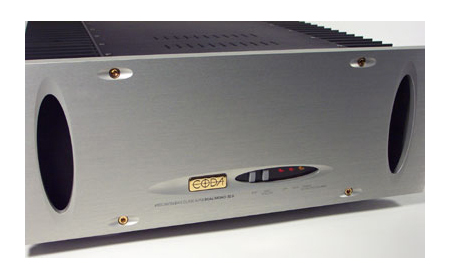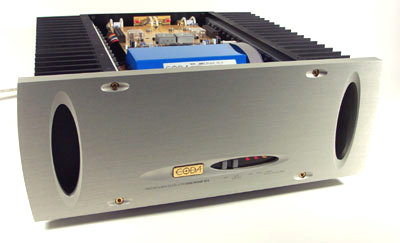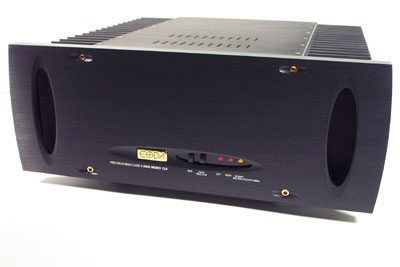You are reading the older HTML site
Positive Feedback ISSUE
13may/june 2004
coda
12.5 and 30.5 amplifiers and 05r preamplifier
as reviewed by Larry Cox

| LARRY COX'S SYSTEM LOUDSPEAKERS ELECTRONICS SOURCE CABLES ACCESSORIES
|
My first high end system was entirely made in the United States: Vandersteen 2Ci speakers, Audible Illusions Modulus 2D preamp, PSE Studio Mk IV amplifier, Sota Sapphire turntable, and CAL Audio CD player. Now, oddly enough, my entire system (except some of the cabling) is British. I'm neither an anglophile nor anti-American—it just happened. That I could have ended up with gear from Germany, from Canada, or from somewhere else tells you something about the current state of audio. There are lots of great things to listen to and live with from all over the world.
Between the time I had my original system and now, I flirted with various brands. One that stood out was Coda, a company that has been low on the review radars for a good part of its life—apparently by design, as it is receiving a lot of press these days. Coda is one of two lines of electronics produced by The Continuum Group of Sacramento, California. Coda is the high end line of the two, and Continuum is the more affordable. The company was founded by some of the folks that made the Threshold name famous.
I was introduced to Coda about ten years ago by James Gregan of Sound Asylum in Venice, California, the dealer who sold me my pair of ATC SCM 20s. Jim has great taste and a knack for finding value, and at the time, he was fond of bridging a pair of Coda 10.5s as monoblocks for the 20s. Those 83-dB-inefficient speakers reacted to the 400 watts of bridged power coursing through them like sailors on holiday. Matches like that don't happen often, and I should have found a way to put together the money for a second 10.5. Alas, a single 10.5 wasn't enough for the 20s, nor was any other "mere" 100-watt amp.
Coda amps have always had a rich sound, with solid, tight bass and an ever-so-slightly soft treble that never reveals a trace of wiry, solid state sound. Coda's sound is very much to my taste. I listen for the sustained tone of instruments. I want to hear the clarity of that sustained tone, and I want the sound to be full-bodied. That's live music to me. I want to hear less of the room, which tends to amplify the attack and decay of notes. Coda electronics have allowed me to hear the kind of sound that I equate to live sound, so when the company enquired whether PFO would be interested in listening to their gear, I jumped at the opportunity to listen.

My initial interest was in the new 30.5 amplifier, which has the same circuit topology and parts as the 12.5, but offers 300 watts in class AB while the 12.5 offers 100 watts in class A. I received both the 12.5 (previously dubbed 12.0 and renamed when a number of mods were implemented) and the 30.5, and the 05r passive preamplifier. The 12.5 and the 30.5 are identical save for the biasing. Sonically, they differ somewhat, but we'll get to that (both amplifiers are identical on the exterior except for model identification).
According to Mark Ward, Coda's Director of Marketing, the 12.5 now bears the upgrades of the 30.5, which means that the edges of the heatsinks are a rather striking polished steel, it has Cardas speaker binding posts, and was assembled using audiophile-grade solder (Cardas Quad Eutectic or Johnson IA-423 Tri Eutectic by request). These upgrades now apply to all Coda amplifiers. Both amps are "precision biased," Coda's trade name for a way of handling power between transistors so that they are driven close to full output. According to Coda's designer, Eric Lauchli:
The Precision Bias topology was developed to provide a much more efficient and elegant implementation of Class A amplification.... Essentially, we are fine-tuning and precisely calibrating circuit parameter control to yield an exceptionally smooth cooperation between the positive and negative output banks.... At lower power levels where most music and listening occurs, the load is shared equally by all devices. As we reach the limits of bias current at higher power, the Precision Bias implementation allows one polarity of outputs to gradually increase its share of the load while the other backs off until one bank has full control of the load and the other is off. Because of the tight control of circuit parameters coupled with high speed, linearity and near perfect matching of the output devices, the transition occurs with virtually no effect on the transfer function of the output stage as a whole. The abrupt and often complex changes that occur in conventional designs when one polarity of devices switches in and out [are] effectively eliminated.... The practical effect of Precision Bias is that a transfer function is achieved that is virtually indistinguishable from conventional very high-current Class A bias levels. Results are equal or superior to a standard "Class A into 2 ohm" design, but without their extreme size, heat, complexity or power consumption.... The end result is that for a given bias current, we can reach much higher power levels before one bank of outputs switches off, giving us excellent efficiency compared to more conventional implementations.
Both amps feature true dual mono construction. The independent toroidal transformers are encased in HUGE, powder blue casings located in front of some really huge capacitors. The amps also employ separate rectification and supply capacitors for each channel. Inputs are received by FETs and are DC-coupled throughout. Current gain is accomplished by bipolar transistors without the use of overall feedback. The power supply, the foundation of good sound in every electronic product, is so over-designed that it cannot be a limiting factor. Both units accept balanced and unbalanced inputs. All circuit boards are double sided and gold plated. The entire chassis is anodized, machined aluminum. The amplifiers employ a proprietary protection circuit to guard against incoming DC and oscillation by switching into standby mode if a problem is detected.
Turning these behemoths off requires a little bit of care. Turn the amp "off" at the rocker switch back of the unit, then unplug the unit, and you are in fine shape. If you unplug the unit without first flicking the rocker switch, the amp's computer will put it into protection mode and you'll have no power for quite some time. I did this, and had to wait about twenty minutes for the power to return. Hardly a problem, but something to note.

The 12.5 produces 100 watts into 8 ohms and 200 into 4 ohms in stereo, 400 and 800 when bridged to mono. The 30.5 produces a prodigious 300 watts into 8 ohms and 600 in to 4 in stereo, and in mono bridged configuration, you're listening to 1200 watts into 8 ohms and 2400 into a 4-ohm load. Talk about a tiger in your tank!
The CODA FET Control Buffer 05r, or preamp if you like, features a true balanced signal path with balanced and unbalanced inputs and outputs. All sources have RCA (unbalanced) inputs. The output buffer consists of a minimalist, paralleled Class A, FET follower. The "r' in the nomenclature indicates remote control of volume and source. You can set volume levels for inputs independent of one another. This is a really great feature, and here's why: If your CD player has a 4-volt output and your tuner has a 1-volt output, you would have very different volume levels when switching from one to the other. With the 05r, you can maintain the same volume levels. Neato. The 05r will also let you independently set balance for each input, which is pretty nifty for oddly shaped rooms or setups with more damping along one wall than another. There is probably more to say about the technical aspects of these components, but that's what I know and thought to tell you, except to add that all Coda products come with a ten-year warranty to the purchaser, five years of which is transferable. That's confidence from Coda and assurance to you.
What you'll ultimately want to know is whether these products sound good. Given the relative characterlessness of my ATC speakers, it wasn't easy to get the measure of the Coda electronics. They operated flawlessly, and gave the impression that there wasn't a speaker that they couldn't drive effortlessly. If I had more money and space, I'd love to have either the 12.5 or the 30.5 as a second amplifier—heck, it could even end up being my first amplifier, and I don't think I'd suffer if I put aside my tube monoblocks and tube preamp. I had the 12.5 and 05r in my main system for two months before I noticed that I hadn't heard my own amps during that time. No, the 12.5 and the 30.5 didn't sound like the E.A.R. monoblocks and tube preamp, but they sounded good enough, and just weren't noticed in the way that some other more "exciting" products are. Those exciting products are widely available for resale on Audiogon.
![]()
The 12.5/05r combination will allow you to pick source components freely, as it won't be adding color of its own. I'll talk first about the 12.5, then highlight the ways in which the 30.5 departs from it. The Codas always had a "rightness" of sound. Their tonality was not hyped up or zippy, and they delivered full macrodynamic expression, which is to say they delivered the scale of music, from quiet to loud, with equal aplomb. On good recordings, they gave a "you are there" experience, with a vividness of presentation that was never bright, sharp, or forward. On drab recordings, things were drab.
The sound could be fast, but in a natural way. There's something about low bass that is slow and steady, like a Mississippi river boat, but it also has an acceleration that both Coda amps provided. Holy Cole's Temptation features a small ensemble with a large standup bass. On "Train Song," the bass was big and full, with a slow but inexorable motion that conveyed not only sustained tone but the speed of the instrument's attack. Both the 12.5 and 30.5 did a fine job on getting the "swoop" of a bottom end swing, like the piano, bass, and drums on the title track of Bruce Katz's Crescent Crawl. This track has a great bluesy, New Orleans feel, and a swing to the bottom end that both amplifiers easily and effortlessly revealed despite the substantial differences in their output.
The bottom end of the 12.5 always seemed sufficient, no matter what music I tried. Only in the amount of low end, not its depth, did the 30.5 show its greater power. This became evident on track 17 of the Ensemble CD, Natural Perspectives in Sound, with its low organ tones. On other large-scale pieces like Grieg's Piano Concerto No. 1, which opens with a thunderous piano passage followed by the full mass of the orchestra, the 30.5 was more nimble, and conveyed a greater sense of rhythm. I don't mean that a listener would be inclined to break dance to the piece, just that the system conveyed the rhythmic connection of different parts of the music. I was able to notice the rhythmic component of each bar of music as it related to the bars that came before and after. The 30.5/05r combo was able to underscore the rhythm without taking away the melody.
The rhythmic impression that the 30.5 conveyed was somewhat like the NAIM signature of marching beats, only played out more subtly, and with a greater variety of music. The 30.5 and the ATC 35s matched really well, giving a nimble, dance-like sense of rhythm to music that might not otherwise be perceived as rhythmic. The 30.5 allowed me to grasp the composer's rhythmic sensibilities in ways that other amps don't. It appears that the 30.5's class AB biasing allows for greater control of the bottom end.
The 12.5 had a quieter, sweeter sound, one that invited comparisons to a tube amplifier. Though my E.A.R. 509 monoblocks were more liquid sounding, I cannot tell you whether that liquidity is more accurate or a coloration, though I bought the 509s because I thought that their liquidity was accurate. My experience of live music is that instruments rarely have so much texture, even grit, that a sense of liquidity is not apparent. The 509s convey this characteristic that I have long found seductive. Neither the 12.5 nor the 30.5 had that liquidity, but the 12.5 has a liveliness that my E.A.R. does not.
With my Ensemble interconnects between components and Jena Labs and Silver Audio interconnects elsewhere, I detected a bit of grain in the midrange, a sort of papery quality, yet after using those interconnects between different components, I no longer had that impression. These amplifiers are so transparent that when things are slightly off, you'll know it, instantaneously, though they don't announce AUDIO EMERGENCY if there is a less-than-optimal match. It simply becomes apparent that something is amiss. Some amps tell you all about image placement and attack/decay, but do so at the cost of sounding lean and bright. The Codas don't fall into that trap.
It is hard to say whether the 12.5 had a "house sound." Imaging was flatter, rather than being three dimensional, but that may be typical of solid state. I didn't really care. Left/right placement was clearly delineated, but front-to-back dimensionality was not as well described as it is by my 509s, or by the very occasional solid state amplifier. The 30.5 sounded more bracing than the more relaxed 12.5, but neither amp was lean or gray. The 30.5 had a greater sense of adrenaline-like speed from the midrange to the upper bass.
As I said, the 12.5 was in my system for about two months. When it first replaced my tubed monoblocks, I thought that I could live with solid state forever, tubes be damned. Then I put the 509s back in the system, and thought that I couldn't possibly go back to the Codas, but this also ended up being incorrect. My second extended listening period with the 12.5 and 30.5 was like the first, with a rich sense of the color and sweep of music immediately available, and I thought perhaps I could keep the system solid state.
The sound of these two amps was hard to pin down. A friend who has a lot of experience with tube electronics thought he would be able to easily identify the two amplifiers, but could not. My dad preferred the 12.5, feeling that it had better, deeper bass than the 30.5, and was quieter. My wife liked the 30.5's greater "swing" factor, feeling that it made music seem as if it was being played faster and more "on time." With large-scale music, the more powerful 30.5 seemed more desirable to me—faster, with a greater sense of urgency—but on smaller-scale music I couldn't reliably distinguish one amp from the other.
Comparing the 05r to my preamp was an easier job, as both did more to the signal than the amplifiers. My E.A.R. 864 had more depth and fullness in the bottom end. The 864 goes deeper in the bass than most (if not all) tube designs, and went deeper than the 05r, though the 05r was more transparent in the bottom octave, before it tapered off. The 864's additional bottom end gave it a fullness and body that the Coda didn't have. The 05r was certainly not lean, but it was more lightweight. It sounded fast rather than lean. I had the sense that the 05r was a bit less vivid than the 30.5, and that it was more akin to the 12.5.
Before hearing the two Coda amps, I was certain that I would prefer the 300-watter. I figured that the 12.5 would be too delicate to do the heavy lifting that my ATCs demand. I was wrong. Both the 12.5 and the 30.5 was more than enough amplifier. I did not have to resort to loud volume levels with either to get all the bass and dynamics that the ATCs offer. I could live easily and happily with either amp and the 05r preamp. Based on the smaller-scale music that I'm listening to at this time in my life, I'd favor the 12.5/05r combination, but if I were listening to large-scale pieces, I'd snap up the 30.5/05r combo. Both are recommended, and definitely worth a listen. Larry Cox

12.5 amplifier
Retail: $6950
30.5
amplifier
Retail: $6950
05r
preamplifier
Retail: $3150
Coda Technologies/The Continuum Group
Tel: 916. 383. 3653
email address:
[email protected]
web address:
www.coda-continuum.com
